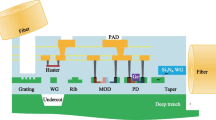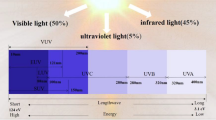Abstract
We present a mathematical and numerical framework for the optimal design of doping profiles for optoelectronic devices using methods from mathematical optimization. With the goal to maximize light emission and reduce the threshold of an edge-emitting laser, we consider a drift-diffusion model for charge transport and include modal gain and total current into a cost functional, which we optimize in cross sections of the emitter. We present 1D and 2D results for exemplary setups that point out possible routes for device improvement.





Similar content being viewed by others
References
Auf der Maur, M.: A multiscale simulation environment for electronic and optoelectronic devices. Ph.D. thesis, University of Rome Tor Vergata (2008)
Bandelow, U., Gajewski, H., Hünlich, R.: Fabry-Perot Lasers: Thermodynamics-Based Modeling, pp. 63–85. Springer, New York (2005)
Barget, M.R., Virgilio, M., Capellini, G., Yamamoto, Y., Schroeder, T.: The impact of donors on recombination mechanisms in heavily doped Ge/Si layers. J. Appl. Phys. 121(24), 245701 (2017)
Burger, M., Pinnau, R.: Fast optimal design of semiconductor devices. SIAM J. Appl. Math. 64(1), 108–126 (2003)
Dutt, B., Sukhdeo, D.S., Nam, D., Vulovic, B.M., Yuan, Z., Saraswat, K.C.: Roadmap to an efficient germanium-on-silicon laser: strain vs. n-type doping. IEEE Photonics J. 4(5), 2002–2009 (2012)
Hinze, M., Pinnau, R.: An optimal control approach to semiconductor design. Math. Models Methods Appl. Sci. 12(01), 89–107 (2002)
Hinze, M., Pinnau, R.: Second-order approach to optimal semiconductor design. J. Optim. Theory Appl. 133(2), 179–199 (2007)
Liu, J., Sun, X., Camacho-Aguilera, R., Kimerling, L.C., Michel, J.: Ge-on-Si laser operating at room temperature. Opt. Lett. 35(5), 679–681 (2010)
Markowich, P.A.: The Stationary Semiconductor Device Equations. Springer, Berlin (1986)
Mielke, A., Peschka, D., Rotundo, N., Thomas, M.: Gradient structures for optoelectronic models of semiconductors. In: Matheon preprint (to appear in Proceedings of ECMI 2016) (2016)
Nagavarapu, V., Jhaveri, R., Woo, J.C.: The tunnel source (pnpn) n-mosfet: a novel high performance transistor. IEEE Trans. Electron Dev. 55(4), 1013–1019 (2008)
Peschka, D., Thomas, M., Glitzky, A., Nürnberg, R., Gärtner, K., Virgilio, M., Guha, S., Schroeder, T., Capellini, G., Koprucki, T.: Modeling of edge-emitting lasers based on tensile strained germanium microstrips. IEEE Photonics J. 7(3), 1–15 (2015)
Peschka, D., Rotundo, N., Thomas, M.: Towards doping optimization of semiconductor lasers. J. Comput. Theor. Transp. 45(5), 410–423 (2016)
Weiser, M., Schiela, A., Deuflhard, P.: Asymptotic mesh independence of Newton’s method revisited. SIAM J. Numer. Anal. 42(5), 1830–1845 (2005)
Acknowledgements
This research was partially supported by the German Research Foundation (DFG) via project B4 in SFB 787 and by the Einstein Foundation Berlin (ECMath) via the Matheon projects OT1/OT8. The authors thank P. Farrell, M. Liero, A. Glitzky and T. Koprucki for fruitful discussions.
Author information
Authors and Affiliations
Corresponding author
Additional information
This article is part of the Topical Collection on Numerical Simulation of Optoelectronic Devices, NUSOD’ 17.
Guest edited by Matthias Auf der Maur, Weida Hu, Slawomir Sujecki, Yuh-Renn Wu, Niels Gregersen, Paolo Bardella.
Rights and permissions
About this article
Cite this article
Peschka, D., Rotundo, N. & Thomas, M. Doping optimization for optoelectronic devices. Opt Quant Electron 50, 125 (2018). https://doi.org/10.1007/s11082-018-1393-4
Received:
Accepted:
Published:
DOI: https://doi.org/10.1007/s11082-018-1393-4




